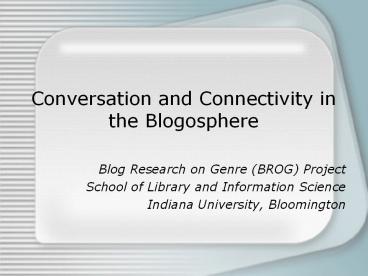Conversation and Connectivity in the Blogosphere - PowerPoint PPT Presentation
1 / 23
Title:
Conversation and Connectivity in the Blogosphere
Description:
Conversation and Connectivity in the Blogosphere. Blog Research on Genre (BROG) Project ... method creates bias towards connectivity. Average blogs may be less ... – PowerPoint PPT presentation
Number of Views:44
Avg rating:3.0/5.0
Title: Conversation and Connectivity in the Blogosphere
1
Conversation and Connectivity in the Blogosphere
- Blog Research on Genre (BROG) Project
- School of Library and Information Science
- Indiana University, Bloomington
2
BROG project members
- Faculty
- Susan Herring
- John Paolillo
- Students
- Ben Clark
- Inna Kouper
- Sarah Mercure
- Lois Ann Scheidt
- Sharon Stoerger
- Pete Welsch
- Elijah Wright
3
The Blogosphere
- the collective term encompassing all weblogs (cf.
blog biosphere) - the intellectual cyberspace inhabited by
bloggers (Wm. Quick, 2001) - blogs as a community blogs as a social network
(www.samizdata.net)
4
Blogs and conversation
- Full-blown conversations are carried on
between three or five blogs, each referencing the
other on their argument or rebuttal of the
others positions - (Newsweek, 2002)
5
Blogs and conversation (cont.)
- Weblogs enable a massively distributed but
completely connected conversation covering every
imaginable topic of interest - (Marlow, 2004)
6
Research questions
- How much conversation takes place in the
blogosphere? - What is it like?
7
Sampling procedure
- Random sampling from blo.gs site
- Selected first four blogs with links to other
blogs in sidebars. - Snowball sampling from random blogs
- Followed and recorded all links to blogs in
sidebars out three degrees of separation. - Result 5,517 unique URLs and 14,890
source-destination pairs - Random sampling from snowball sample
- 50 blogs with minimum 5 posts in March 2005
8
Resultant data sample
- Established, active blogs
- Links in sidebar
- Part of a loose network
- Resemble blogs most often discussed in the media
and blog research (Herring et al., 2004b)
9
Analytical methods
- Social network analysis of links in snowball
sample (n5,517 blogs) - Visualization of most densely interlinked blogs
(n254 blogs) - Content analysis of posts and comments (n50
blogs) - See Herring et al. (2005). Conversations in the
blogosphere An analysis from the bottom up.
HICSS 38.
10
Visualization
- Pajek
- Cut-off at 10 in-degrees
- Three main clusters
- Catholicism
- Homeschooling
- A-list (political commentary humor)
11
(No Transcript)
12
Content analysis
- For each blog (A)
- Coded conversational units
- References in posts
- Comments
- Coded connections between units
- Distinguished within sample (B) and outside
sample (non-B) references and comments - One month (March 2005) coded
- Entirely, for B blogs
- 1st three posts 1st 10 comments per post, for
non-B blogs
13
Example references
- Power Line has good news about Iraq a topic that
Glenn Reynolds notes is apparently unfit to print
in The New York Times. blog name blogger
name - Indeed, as the man who first linked to Frizzell
would say. indirect nominal reference - Get Well Soon, Blogfaddah. direct address
14
Example comments
- ...examine how National Guard deployments are
affecting state readiness. - readiness for what? the Parti Québécois tank
units that are massing at the border? quotes and
responds - This is actually very good news for Firefox
users. deictic reference - Attila Girl, () I am sorry for what you went
through. I hope you have peace with it. direct
address 2nd person pronouns
15
A blog conversation
- (Post by Blogger A) Blogger non-B says ltlinkgt,
and I disagree - (Comment by Blogger non-B) Blogger A, you
misunderstood me - (Comment by Blogger A) Blogger non-B, thanks for
your reply
16
Results Conversational units
- N582 units
- References in posts to other blog(ger)s N135
- Mostly blogger's name, blog name, and link to
content - Hyperlinked 48 Trackback 10.3
- Comments by other bloggers N447
- Mostly implicit and 2nd person address
17
Connections between units
- 0 references reply to a post in another blog in
the sample - Comments reply by definition
- To current post (83)
- To previous comment in thread (17)
- Longest exchange in sample (post comments) 5
units
18
Inside vs. outside sample
- References to B 29
- Linked from sidebar to B 49
- References to non-B 71
- Linked from sidebar to non-B 31
- Comments by B 0
- Linked from sidebar to B 0
- Comments by non-B 83
- Linked from sidebar to non-B 27
19
Summary
- More comments than references in posts
participate in conversations - Comments address other bloggers directly
- References refer to other bloggers and/or link to
their content - Most comments and references involve blogs
outside the sample - Only 27-49 of blogs that are conversed with are
also linked from the sidebar
20
Conclusions
- Not all blogs interconnect, although some do
- Conversing blogs dont necessarily link to each
other - Most blog conversations in sample take place in
comment threads, not posts
21
Study limitations
- Sampling method creates bias towards connectivity
- Average blogs may be less conversational
- Did not track reciprocal conversations outside
the sample - References in posts may receive responses from
blogs elsewhere - 50-blog sample is small
- May not represent the blogosphere as a whole
22
Future research
- Need for systematic, large-scale study of
exchanges among bloggers - Need to take account of private (e.g., email, IM)
as well as public exchanges
23
brog_at_stderr.org































